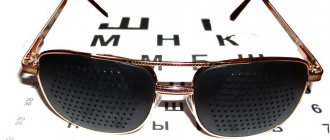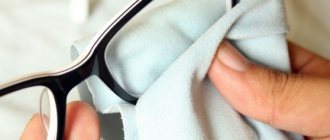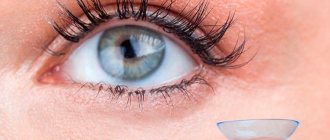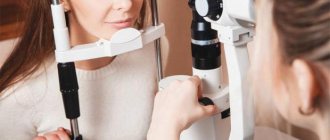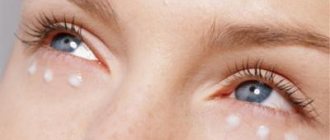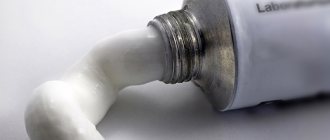Make an appointment with an ophthalmologist
for vision diagnostics on a day and time convenient for you.
In Moscow, seven days a week. Over the past 24 hours, we have accepted 7 applications for diagnostics.
A very special type of glasses, which are created not for vision correction, but for eye training - perforation glasses, trainers, invented by the famous doctor and scientist Svyatoslav Fedorov. They consist of a frame and black opaque plastic plates, along the entire surface of which small round holes are randomly applied.
Indications for use
This simulator is recommended for use by students and schoolchildren with significant visual loads; people who spend a lot of time in front of a computer monitor; for fans of television viewing and computer games. In addition, it will be very useful for persons with any visual impairment (myopia, farsightedness or astigmatism); with high eye fatigue, as a method of preventing spasm of accommodation; as sunglasses, and even in cases of general fatigue or neurosis, as a relaxing, sedative. Training glasses can also be successfully used as a component of pleoptic treatment for amblyopia.
Other
Hole glasses were discussed in Elena Malysheva’s program “Health”[4]. During the graduation, Doctor of Medical Sciences Mikhail Konovalov expressed the opinion that if vision problems arise, one should resort to traditional methods of restoration and correction. And for diseases such as glaucoma and retinal dystrophy, such glasses are completely contraindicated. Malysheva herself called the glasses “money thrown away.” The possible relaxation effect of the glasses, which the manufacturers claim, was not mentioned in the program.
Effect of training glasses
The main therapeutic effect of this device is to diaphragm the light flux. The holes in the glasses made in a certain sequence allow you to increase the depth of field. This means that images of objects, even despite refractive errors, will fall into the area of the retina with the greatest visual acuity.
Training glasses are able to correctly distribute the load, giving rest to tense eye muscles and loading weakened ones. The result of this is the relief of eye fatigue, and with long-term persistent training, the decline in visual acuity may also stop.
Another therapeutic feature of these glasses is psychological relief. Also U.G. Bates, the author of the famous non-drug method for restoring vision, argued that the main goal in any treatment is to relax the psyche and achieve a state of peace. In people with poor vision, the eye muscles are always tense, and this involuntarily affects the general condition. By relaxing the eye muscles, this simulator automatically gives rest to the entire body, producing a slight relaxing effect.
Efficiency of use
The medicinal properties are the subject of much debate. The Ministry of Health of the Russian Federation, referring to the “Committee on New Technology,” authorized the production of training glasses, but at the same time considering them only a means of temporary vision correction. The therapeutic significance of perforation glasses is confirmed only by advertising materials, sometimes presented by sellers as the opinions of ophthalmologists, for example, the non-existent Professor G. A. Borodin from the also non-existent Russian Ophthalmological Institute. It should be added that there are no clinical studies in this area, and the need for regular wearing should be consulted with an ophthalmologist.
How to use training glasses correctly
The training glasses only need to be worn for half an hour a day. They are quite comfortable to read or write, watch TV, work at the computer; the only requirement is good lighting. When looking through glasses, you need to try not to look at one point: a “frozen gaze” will not give a positive effect, but, on the contrary, will lead to unnecessary eye strain. Make your eyes move, look at objects, moving from one detail to another, alternate looking into the distance and at objects nearby.
It is advisable for people with increased visual load (students, computer operators) to use this device for 10 minutes for every hour of visual work.
Training glasses can be worn outside in sunny weather, replacing sunglasses with them.
Hard training in these glasses combined with a properly selected set of exercises and under the supervision of an ophthalmologist will help improve vision or, at least, stop its further deterioration.
Important!
It is worth remembering that you can use training glasses only in sufficiently good lighting. They cannot be used to work with sharp, wounding objects. You should not wear the device for more than two hours a day.
Disadvantages and contraindications
The disadvantages include the fact that the opaque screen limits the flow of light into the eyes and regular wearing of such glasses may be poorly tolerated by a person. Wearing in low light conditions is not recommended. Also among the disadvantages of use, it should be noted that constantly wearing such glasses can cause harm [2], in particular, deteriorate binocular vision.
Contraindications include progressive myopia and nystagmus. For glaucoma and retinal diseases, glasses can only be used after consulting an ophthalmologist.[3][2]
Diagnosis and treatment: selection of glasses and lenses for astigmatism
The symptoms of an anomaly cannot be ignored: at an early stage, while the magnitude of the error is small, it is easier to correct it. If the situation is left unattended, the condition may worsen: concomitant diseases may develop - refractive strabismus, amblyopia. To identify a defect, ophthalmologists at our clinic use:
- visometry - checking the clarity of vision;
- retinoscopy - a method for determining the refraction of the eye using light without the red part of the spectrum;
- eye biomicroscopy - a method of studying the cornea to identify degenerative or inflammatory diseases;
- ophthalmoscopy - examination of the fundus and vitreous body.
Sometimes other studies are carried out to determine the cause of the anomaly. In medical care, ophthalmologists carefully examine each patient and, based on the diagnostic results, select optics (special toric contact lenses, glasses for astigmatism).
Soft contact lenses smooth the cornea, so they correct a small degree even without cylindrical force. You should not choose optics yourself: this will worsen the situation. Patients with astigmatism need to be regularly seen by an ophthalmologist to change glasses or lenses to stronger or weaker ones.
Operating principle of Super-Vision perforated glasses
Perforation glasses are similar to ordinary optical products only in shape. They are a frame with black plastic lenses, in which several holes are made. Their diameter is 1-1.5 mm. They are all equidistant from each other. Each of the holes is capable of transmitting a thin beam of light. They combine into one stream, which first enters the pupil and then the lens. Thanks to this, disturbances in the refractive abilities of the eyeball are partially eliminated. The image becomes clear and contrasty, as with good vision. In this case, several effects are achieved at once. Reduces eye strain and improves visual acuity.
The principle of perforation glasses is based on natural reflexes. People with refractive errors, unless they wear optics, constantly squint. This reduces the intensity of the light flux and slightly improves the quality of vision. Training glasses work the same way as squinting. This is the only way to reduce eye strain.
Links
- The truth about pinhole glasses // Independent, 29 July 1997
- Giuseppe Colicchia.
Pinhole Glasses (English) // The Physics Teacher. - 2008. - Vol. 46. - DOI:10.1119/1.2823996. - Marketers of “Pinhole” Eyeglasses Settle FTC Charges That They Made False and Unsubstantiated Claims That the Glasses Could Correct or Cure Vision Disorders // FTC News Release October 21, 1993
| This article lacks links to sources of information. Information must be verifiable, otherwise it may be questioned and deleted. You may edit this article to include links to authoritative sources. This mark was set on March 29, 2013 . |
Notes
- Fedorov Yu. V., Fedorova A. Yu. Perforation glasses // News of higher educational institutions. Instrumentation. - 2014. - T. 57. - No. 5.
- ↑ 1234
Perforation glasses - Perforation glasses (“Glasses with holes”) - Perforation glasses: indications and contraindications”, Yu. Z. Rosenblum, T. S. Egorova, U. V. Dyadina, Moscow Research Institute of GB named after. Helmholtz, Moscow, journal “Bulletin of Optometry”, No. 3, 2004
- Glasses in a hole. From 11:50
User reviews
Reviews found on the Internet from owners of such training glasses are very ambiguous. Some confidently claim that glasses really help maintain a calm, functional state of the eyes. Others rush to accuse manufacturers of releasing another “dummy” onto the market, the entire benefit of which is an advertising gimmick.
However, independent ophthalmologists state that there are actually benefits from such correction models. The main thing is to remember that glasses with holes are not therapeutic, and certainly cannot replace ordinary glasses with diopters. Even if you regularly wear such perforated lenses, this will not correct your vision and will not return it to its original state.
Their task is to eliminate defects in the optical system of the human eye, which are caused by excessive visual fatigue. Glasses are designed to relax and relax the eye muscles, relieve excess tension, as well as for preventive eye training.
Many users claim in their reviews that perforated lenses have healing properties. However, experts have a different opinion on this matter. On the contrary, ophthalmologists do not recommend pinning too much hope on perforation.
The holes only help to effectively relieve eye strain and they are very useful for those who constantly work at the computer, count or read a lot. With the help of glasses with holes you can get rid of headaches quite easily. In addition, they are an excellent prevention of the development of refractive errors - even when good vision is still preserved. But, with regards to the therapeutic effect, even what is observed is short-lived. It is explained by the fact that due to artificial amplification, the image in glasses becomes clearer. This effect persists for some time after removing the glasses, but then completely disappears.
Contraindications
As for the existing contraindications for wearing corrective glasses, they are very conditional. In particular, these include the patient’s infancy (early age), previous mental disorders, individual intolerance to spectacle frames, etc.
Reviews of perforation glasses trainers
Reviews about glasses for vision correction are mostly positive, coupled with the main treatment, such correction gives good results.
Video for reflection on the benefits of perforation glasses:
It turns out that even in ancient times, people made desperate attempts to improve their vision by using certain objects with a “mesh”. Hunters even had a very strange custom that required them to inspect the area through a fine sieve. In this way, people sought to improve their vigilance...
In Ancient Greece, optical lenses made from rock crystal were used, as evidenced by numerous archaeological excavations. Most likely, primitive lenses served as an optical device for vision correction...
In ancient Rome, according to legend, one of the emperors Nero successfully used emerald lenses to correct vision...
According to medical treatises on glass lenses, the real “age” of glasses is at least 600 years. The first mention of them was recorded at the end of the 13th century. Even then, people made their first guesses about the benefits of using objects that impede vision.
Just a couple of years ago, the counters of opticians and even ordinary haberdashery stores were literally “inundated” with glasses of an unusual model. Instead of glass, these glasses had plastic lenses, completely strewn with perforations in the form of small holes-holes made in a certain way. Surely, many remember what we are talking about, but still do not understand why such an accessory is needed.
Many functions were attributed to glasses with holes, including making it easier to work at the computer. However, their real purpose is to train the eyes, get rid of visual fatigue, and relax the organ of vision. But let’s figure it out together whether these miracle simulators really help.
The action of the simulator and its benefits
What is the point of wearing such a device? The one who puts them on for the first time states that it is as if he is peeking through a hole, that is, the diaphragm effect is at work. In the process of such peeping vision, a person’s gaze is focused on the so-called macula. This is the point of best image quality. The eyes can see everything, but after taking off the glasses and clear vision, the pictures before the eyes become blurry. This means that the patient sees better only with glasses. Without them, everything returns to normal.
Thus, diffractive lenses improve vision only at the moment of their use. They simply create a temporary illusion of improved vision. This is confirmed by ophthalmologists themselves and by those who used Fedorov’s simulator. Patients of all ages note this magical short-term effect. But their daily use has absolutely no effect on improving vision in the long term. Perforation glasses do not improve visual acuity. This is noted by 80% of users. Moreover, some people, especially older people, note that after some time of using such a simulator, their vision deteriorated. And only in isolated cases, patients with visual problems note that they began to see a little better after becoming familiar with such a device. But, as eye doctors themselves note, perhaps in this case the placebo effect is triggered, that is, faith and self-hypnosis in the therapeutic effect of such a remedy. In most cases, users note a reduction in tension, eye fatigue, and a stop in the deterioration of visibility. Those patients who have experienced the effects of other methods of improving the functioning of the visual system state that Fedorov’s glasses are the worst correction option. They advise correcting vision using specially developed techniques by Bates, Utekhin, Zhdanov, Norbekov, Avetisov.
Some ophthalmologists recommend that their patients enhance the effect of the simulator if they have problems with the visual system by wearing it and performing special exercises. This is, for example, rotating the eyes in a circle in one direction and the other; shifting the gaze from distant objects to nearby ones; watching your index finger moving towards and away from your nose. It is recommended to do such training daily, gradually increasing the number of repetitions.
